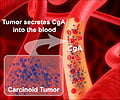New nuclear medicine procedure showed promise for better detection of neuroendocrine tumors, stated study.

‘A new nuclear medicine procedure could safely and more effectively detect cancerous gastrointestinal and pancreatic neuroendocrine tumors than current methods.’





Most GEP-NETs express a high density of somatostatin receptor subtype 2 (sst2). These receptors have, therefore, become a prime target for imaging and treating these tumors. Currently, gallium-68 (68Ga)-DOTATOC/-TATE for diagnostic imaging and lutetium-177 (177Lu)-DOTATOC/-TATE for therapy are paired for "theranostic" identification and treatment of NETs. Preclinical and preliminary clinical evidence indicates that the novel radiolabeled tracer 68Ga-OPS202, an sst antagonist with a high affinity for sst2, has the potential to perform better than an sst agonist such as 68Ga-DOTATOC because 68Ga-OPS202 binds to more sst receptor binding sites than sst agonists.
This first-in-human Phase 1/2 study, included 12 patients with well differentiated GEP-NETs. Based on total numbers of detected malignant lesions, the optimal time window for the scan was determined to be between 1 and 2 hours. The study shows that 68Ga-OPS202 is rapidly cleared from the blood, resulting in low background activity, especially in the liver and gastrointestinal tract.
"Even though the effective dose of 68Ga-OPS202 is comparable to other 68Ga-labeled somatostatin analogs, there are striking differences concerning its biodistribution and organ doses such as liver, gastrointestinal tract, pancreas, lung and spleen," explains Damian Wild, MD, PhD, University Hospital Basel in Basel, Switzerland.
He points out, "The lower organ doses and tracer uptake of 68Ga-OPS202, especially in the gastrointestinal tract and the liver, is clinically relevant, as it allows improvement of the imaging contrast (tumor-to-background ratios) and sensitivity for detecting primary tumor or liver metastases of GEP-NETs (as shown in comparison to 68Ga-DOTATOC in Phase 2 of the study, also published in the June JNM). Important for patients is that 68Ga-OPS202 was well tolerated and did not raise any safety concerns."
Advertisement
Source-Eurekalert













